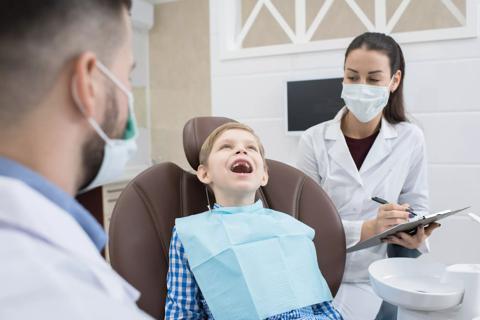Time is of the essence — contact your child’s dentist immediately

Kids are amazing. That scraped knee that would have you laid up all weekend? They run on it. That tumble they took at the roller rink? It was upsetting for a moment, sure. But then they were back up and rolling away before you could even catch up. That time they somehow managed to get tackled in a game of flag football? You were terrified. They thought it was hilarious.
Advertisement
Cleveland Clinic is a non-profit academic medical center. Advertising on our site helps support our mission. We do not endorse non-Cleveland Clinic products or services. Policy
Resilient as they are, children aren’t made of Teflon™. And neither are their teeth.
The medical term for a knocked loose tooth is tooth luxation. It happens when some kind of trauma damages the tissue, ligaments or bone holding your kid’s tooth in their mouth. It might be tempting to just wait and see what happens if your child knocks a tooth loose. But you shouldn’t wait.
We talked to dentist Anne Clemons, DMD, about the different kinds of tooth luxation, why it’s important your child be seen within 24 hours and the different approaches dentists take for baby vs. adult tooth luxation.
There are five different kinds of injuries that can happen when a child’s tooth is knocked loose. In some cases, the type of luxation is obvious. If the injury isn’t that straightforward, the dentist will do some X-rays.
| Injury type | What happened | Did the tooth move? | Is the tooth loose? |
|---|---|---|---|
| Concussion | The tissue supporting the tooth was damaged. | No. | No. |
| Subluxation | The tissue supporting the tooth was damaged. | No. | Yes. |
| Extrusive luxation | The periodontal ligament separated. | Yes. | Yes. |
| Lateral luxation | The alveolar bone fractured and periodontal ligament separated. | Yes. | No. |
| Intrusive luxation | The tooth moved up, fracturing the alveolar bone. | Yes. | No. |
| Injury type | |||
| Concussion | |||
| What happened | |||
| The tissue supporting the tooth was damaged. | |||
| Did the tooth move? | |||
| No. | |||
| Is the tooth loose? | |||
| No. | |||
| Subluxation | |||
| What happened | |||
| The tissue supporting the tooth was damaged. | |||
| Did the tooth move? | |||
| No. | |||
| Is the tooth loose? | |||
| Yes. | |||
| Extrusive luxation | |||
| What happened | |||
| The periodontal ligament separated. | |||
| Did the tooth move? | |||
| Yes. | |||
| Is the tooth loose? | |||
| Yes. | |||
| Lateral luxation | |||
| What happened | |||
| The alveolar bone fractured and periodontal ligament separated. | |||
| Did the tooth move? | |||
| Yes. | |||
| Is the tooth loose? | |||
| No. | |||
| Intrusive luxation | |||
| What happened | |||
| The tooth moved up, fracturing the alveolar bone. | |||
| Did the tooth move? | |||
| Yes. | |||
| Is the tooth loose? | |||
| No. |
Of course, it’s also possible to knock a tooth all the way out. More on that later.
While some luxation injuries are more severe than others, Dr. Clemons advises that you should always get your kid to a dentist or endodontist within 24 hours of the incident. Your provider has both the expertise and the technology to determine what exactly happened and what the best treatment option is.
Advertisement
Why is the 24-hour window so important? “If there’s a delay, the bone can firm up, making it difficult to realign the tooth,” she explains.
How a dentist treats a tooth that’s been knocked loose depends on several factors, chief among them whether the chomper in question is a baby tooth or an adult tooth.
“With baby teeth, a dentist can often reposition the tooth with just a finger within the first couple of hours,” Dr. Clemons explains.
If the dentist can’t reposition the baby tooth without performing what Dr. Clemons calls “major manipulation,” it’s probably just going to stay crooked. The other option is extraction.
“If the tooth needs to be manipulated a lot, we run the risk of damaging the developing permanent tooth,” Dr. Clemons further explains. The risk isn’t worth it for a tooth that’s going to fall out eventually anyway.
Adult teeth, as you can imagine, are a different story.
“For an adult tooth, the dentist will need to reposition it quickly,” Dr. Clemons clarifies. “They may need to secure the tooth with stabilizing wires or dental material. And that has to happen as soon as possible after the tooth movement.”
What if the tooth got knocked all the way out? Is that a salvageable situation, too?
It might be.
It’s sometimes possible to re-implant a tooth that’s fallen out, but it needs to happen fast — like, within 30 minutes of the accident fast. Doing these two things can improve the chances of success. But keep in mind that not all teeth can be re-implanted. “We never re-implant primary (baby) teeth because of the risk of damaging the developing permanent tooth,” Dr. Clemons says. “Only permanent teeth are recommended for reimplantation.”
Emergency dentistry isn’t most people’s idea of a good time. But if your child has knocked their tooth loose — or all the way out — you’ll need to act fast. The quicker you get to the dentist, the better the chances they’ll be able to fix the problem, and preserve your child’s oral health.
Advertisement
Learn more about our editorial process.
Advertisement

Acting fast can make a difference

Bleeding is a risk and warrants taking care, but the reward of this lifesaving medication is great

Severe and debilitating headaches can affect the quality of your child’s life

With repeat injections over time, you may be able to slow the development of new wrinkles

Although it can be alarming, it’s normal to experience blood clots during menstruation

Type 2 diabetes isn’t inevitable with these dietary changes

Applying a hot or cold compress can help with pain